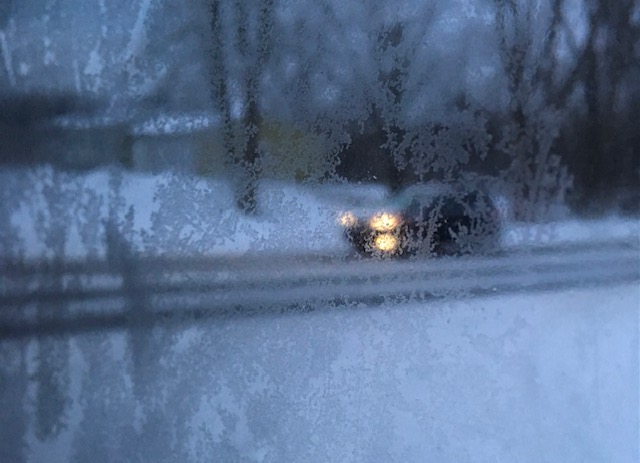FHC Students have mixed feelings about driving in the snow
The snow is not junior Seth Bush’s friend.
For a new driver, driving in the snow can be very intimidating. One month into having his driver’s license, disaster struck on the road one snowy morning.
“I drove my mom to church,” Seth said, “and on the way back, [the road] had not been plowed yet so everything was white ice. I slid my truck off the side of the road, sideswiped a sign, and went into a ditch.”
Crashing only about a block away from his house, the whole event seemed surreal to Seth.
“I got out [of the truck], and it didn’t hit me that I crashed until I came back and saw it again,” Seth said. “And I was like, that’s really not good.”
Sometimes there’s nothing that can be done to prevent sliding on hidden snow or ice, as Seth experienced first-hand. The treacherous Michigan roads hide black ice within snowy patches that make the road hard to see. When going around a curve, the tires might not respond to the motion and could lose control.
“I turned the wheel to go around a curve and the truck didn’t turn with it,” Seth said.
Luckily, someone was driving by; they saw the scene and called the police to help Seth.
A loader ended up pulling the truck out of the ditch he had landed in. Two fire trucks arrived at the scene along with a couple of squad cars who surveyed the accident soon after.
Thankfully, the harm that came out of this incident was minor. Seth received a ticket, but it didn’t take any points off of his license.
“They saw [that] I’ve never been in an accident before,” Seth said, “so they didn’t call it reckless driving. They [also] saw [that] I only had my license for a month.”
Learning from this traumatic misfortune, Seth is even more cautious as he takes all the factors of snow driving into consideration, such as letting his tires keep rolling at a stoplight and giving himself more time to stop at intersections to avoid sliding.
“At first, I wasn’t really scared of [snow driving],” Seth said, “but now I will definitely be more careful [driving] in the snow.”
As a more experienced driver, even senior Katie Ritzema has had her fair share of close calls in the snow.
Last year on Veteran’s day, it was a blizzard of snow, and the roads were coated with ice. As Katie was on her way to school, a slippery hill sent her sliding.
“I have to go down a hill to get out of my neighborhood,” Katie said. “I was going super slow, but the car in front of me was going a tiny bit slower than I was. [The car and I] were both going down the hill and it was all ice, so I couldn’t really stop at all. So I ended up having to go next to [the car] in front of me in the [other] lane. We got to the bottom of the hill, and I didn’t end up hitting the car or anything.”
Ice, among other dangerous elements, is a popular concern for most drivers who don’t enjoy sliding out of control during the winter season.
Sometimes, the only way to truly learn is through experience. From her driving expeditions, Katie has picked up on some tips as she drives in inconvenient weather conditions.
“Go really slow,” Katie advised, “even if the other people around you are going fast. Don’t go so slow that it’s going to be dangerous for you, but go slow enough that you feel comfortable. Don’t let the people around you going faster scare you.”
Drivers, no matter how experienced they are with driving, tend to understand the need to go slower and take more precautions, so it’s an important factor to take into consideration that you pay attention to the vehicles around you.
Katie also mentioned that stopping at an intersection, with a significant amount of space behind the stop line, will be better for in the long run, especially if a previous car is unable to stop. By staying back far enough, it can prevent getting pushed into the middle of the intersection.
While the snow is intimidating for Katie and Seth, sophomore Gabby Hendricks is one who doesn’t fear the snow.
“Honestly, I feel pretty comfortable [driving in the snow],” said Gabby, who has had her license for about a month now. “I’ve lived in Michigan for a while so I’m kind of used to it.”
Heavy practice with driving in the snow will lead to being accustomed to the normalcies and precautions that come with the weather.
Even though accidents in dangerous conditions are sometimes not the driver’s fault, taking all the different factors that go into driving in the snow into consideration can help prevent further accidents from happening. Taking time, being very hyper-aware of surroundings, and leaving some extra space at intersections are great ways to be safe in snowy conditions.
To prevent potential accidents, Gabby makes sure to be well prepared before venturing out into the snowy traffic.
“I just go slower, wake up earlier, take more time to prepare to drive so I can take my time on the roads and not have to rush and be quick and slide,” Gabby said. “Be really aware and don’t act like you’re just driving in normal conditions because it’s a lot different. Be more cautious and take your time on the snow and ice.

Liza McCarthy is a senior who is excited for her second and final year on staff. This year, she is taking on the new role of Podcast Manager which will...

























































































